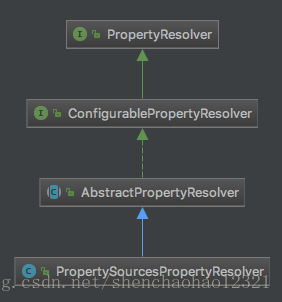PropertySourcesPropertyResolver用来将PropertySource的占位符文本解析,PropertyResolver是 Environment的顶层接口,主要提供属性检索和解析带占位符的文本。

public interface PropertyResolver {
boolean containsProperty(String key);
@Nullable
String getProperty(String key);
String getProperty(String key, String defaultValue);
@Nullable
<T> T getProperty(String key, Class<T> targetType);
<T> T getProperty(String key, Class<T> targetType, T defaultValue);
String getRequiredProperty(String key) throws IllegalStateException;
<T> T getRequiredProperty(String key, Class<T> targetType) throws IllegalStateException;
String resolvePlaceholders(String text);
String resolveRequiredPlaceholders(String text) throws IllegalArgumentException;
}
ConfigurablePropertyResolver定了解析占位符的一些配置方法。
public interface ConfigurablePropertyResolver extends PropertyResolver {
ConfigurableConversionService getConversionService();
void setConversionService(ConfigurableConversionService conversionService);
void setPlaceholderPrefix(String placeholderPrefix);
void setPlaceholderSuffix(String placeholderSuffix);
void setValueSeparator(@Nullable String valueSeparator);
void setIgnoreUnresolvableNestedPlaceholders(boolean ignoreUnresolvableNestedPlaceholders);
void setRequiredProperties(String... requiredProperties);
void validateRequiredProperties() throws MissingRequiredPropertiesException;
}
AbstractPropertyResolver封装了解析占位符的具体实现,而PropertySourcesPropertyResolver主要是负责提供数据源。AbstractPropertyResolver中有两个成员变量都是PropertyPlaceholderHelper对象,区别在于构造参数不同。
public PropertyPlaceholderHelper(String placeholderPrefix, String placeholderSuffix,
@Nullable String valueSeparator, boolean ignoreUnresolvablePlaceholders) {
Assert.notNull(placeholderPrefix, "'placeholderPrefix' must not be null");
Assert.notNull(placeholderSuffix, "'placeholderSuffix' must not be null");
this.placeholderPrefix = placeholderPrefix;
this.placeholderSuffix = placeholderSuffix;
String simplePrefixForSuffix = wellKnownSimplePrefixes.get(this.placeholderSuffix);
if (simplePrefixForSuffix != null && this.placeholderPrefix.endsWith(simplePrefixForSuffix)) {
this.simplePrefix = simplePrefixForSuffix;
}
else {
this.simplePrefix = this.placeholderPrefix;
}
this.valueSeparator = valueSeparator;
this.ignoreUnresolvablePlaceholders = ignoreUnresolvablePlaceholders;
}
placeholderPrefix和placeholderSuffix是从AbstractPropertyResolver传过来的${和},代表占位符的边界符号。valueSeparator也是传过来的默认值分隔符“:”。ignoreUnresolvablePlaceholders是否忽略占位符中不存在的数据源,false会抛出IllegalArgumentException。
replacePlaceholders()方法用来将value中占位符替换为从Properties或PlaceholderResolver取得的值。
public String replacePlaceholders(String value, final Properties properties) {
Assert.notNull(properties, "'properties' must not be null");
return replacePlaceholders(value, properties::getProperty);
}
public String replacePlaceholders(String value, PlaceholderResolver placeholderResolver) {
Assert.notNull(value, "'value' must not be null");
return parseStringValue(value, placeholderResolver, new HashSet<>());
}
PlaceholderResolver是一个接口定了一个方法,入参为占位符参数名,出参为占位符代表的值。这个对象由PropertySourcesPropertyResolver传入,具体后面再说。具体的解析占位符就是通过parseStringValue()方法了:
protected String parseStringValue( String value, PlaceholderResolver placeholderResolver, Set<String> visitedPlaceholders) {
StringBuilder result = new StringBuilder(value);
int startIndex = value.indexOf(this.placeholderPrefix);
while (startIndex != -1) {
int endIndex = findPlaceholderEndIndex(result, startIndex);
if (endIndex != -1) {
String placeholder = result.substring(startIndex + this.placeholderPrefix.length(), endIndex);
String originalPlaceholder = placeholder;
if (!visitedPlaceholders.add(originalPlaceholder)) {
throw new IllegalArgumentException(
"Circular placeholder reference '" + originalPlaceholder + "' in property definitions");
}
// Recursive invocation, parsing placeholders contained in the placeholder key.
placeholder = parseStringValue(placeholder, placeholderResolver, visitedPlaceholders);
// Now obtain the value for the fully resolved key...
String propVal = placeholderResolver.resolvePlaceholder(placeholder);
if (propVal == null && this.valueSeparator != null) {
int separatorIndex = placeholder.indexOf(this.valueSeparator);
if (separatorIndex != -1) {
String actualPlaceholder = placeholder.substring(0, separatorIndex);
String defaultValue = placeholder.substring(separatorIndex + this.valueSeparator.length());
propVal = placeholderResolver.resolvePlaceholder(actualPlaceholder);
if (propVal == null) {
propVal = defaultValue;
}
}
}
if (propVal != null) {
// Recursive invocation, parsing placeholders contained in the
// previously resolved placeholder value.
propVal = parseStringValue(propVal, placeholderResolver, visitedPlaceholders);
result.replace(startIndex, endIndex + this.placeholderSuffix.length(), propVal);
if (logger.isTraceEnabled()) {
logger.trace("Resolved placeholder '" + placeholder + "'");
}
startIndex = result.indexOf(this.placeholderPrefix, startIndex + propVal.length());
}
else if (this.ignoreUnresolvablePlaceholders) {
// Proceed with unprocessed value.
startIndex = result.indexOf(this.placeholderPrefix, endIndex + this.placeholderSuffix.length());
}
else {
throw new IllegalArgumentException("Could not resolve placeholder '" + placeholder + "'" + " in value \"" + value + "\"");
}
visitedPlaceholders.remove(originalPlaceholder);
}
else {
startIndex = -1;
}
}
return result.toString();
}
这是一个递归的解析过程,遇到${开头就会查找最后一个}符号,将最外层占位符内的内容作为新的value再次传入 parseStringValue()方法中,这样最深层次也就是最先返回的就是最里层的占位符名字。调用placeholderResolver将占位符名字转换成它代表的值。如果值为null,则考虑使用默认值(valueSeparator后的内容)赋值给propVal。由于placeholderResolver转换过的值有可能还会包含占位符所以在此调用parseStringValue()方法将带有占位符的propVal传入返回真正的值,用propVal替换占位符。如果propVal==null,判断是否允许忽略不能解析的占位符,如果可以重置startIndex继续解析同一层次的占位符。否则抛出异常。这个函数的返回值就是它上一层次的占位符解析值。
需要注意的一点是:判断嵌套的占位符是依据simplePrefix。
private int findPlaceholderEndIndex(CharSequence buf, int startIndex) {
int index = startIndex + this.placeholderPrefix.length();
int withinNestedPlaceholder = 0;
while (index < buf.length()) {
if (StringUtils.substringMatch(buf, index, this.placeholderSuffix)) {
if (withinNestedPlaceholder > 0) {
withinNestedPlaceholder--;
index = index + this.placeholderSuffix.length();
}
else {
return index;
}
}
else if (StringUtils.substringMatch(buf, index, this.simplePrefix)) {
withinNestedPlaceholder++;
index = index + this.simplePrefix.length();
}
else {
index++;
}
}
return -1;
}
AbstractPropertyResolver解析占位符的方法就是委托了PropertyPlaceholderHelper对象的replacePlaceholders()方法,placeholderResolver参数由抽象方法getPropertyAsRawString()定义,子类给出具体实现。
@Override
public String resolvePlaceholders(String text) {
if (this.nonStrictHelper == null) {
this.nonStrictHelper = createPlaceholderHelper(true);
}
return doResolvePlaceholders(text, this.nonStrictHelper);
}
@Override
public String resolveRequiredPlaceholders(String text) throws IllegalArgumentException {
if (this.strictHelper == null) {
this.strictHelper = createPlaceholderHelper(false);
}
return doResolvePlaceholders(text, this.strictHelper);
}
private String doResolvePlaceholders(String text, PropertyPlaceholderHelper helper) {
return helper.replacePlaceholders(text, this::getPropertyAsRawString);
}
@Nullable
protected abstract String getPropertyAsRawString(String key);
getProperty()方法也是子类给出的具体实现,下面看一下PropertySourcesPropertyResolver。
构造方法会传入一个PropertySources对象作为数据源。
public PropertySourcesPropertyResolver(@Nullable PropertySources propertySources) {
this.propertySources = propertySources;
}
PropertyPlaceholderHelper需要的PlaceholderResolver函数方法。
@Override
@Nullable
protected String getPropertyAsRawString(String key) {
return getProperty(key, String.class, false);
}
可以看出核心方法就是getProperty(),这里resolveNestedPlaceholders传入的是false,因为占位符解析是交给了PropertyPlaceholderHelper对象,不需要PropertySourcesPropertyResolver再次使用父类的resolveNestedPlaceholders再次解析占位符。
@Nullable
protected <T> T getProperty(String key, Class<T> targetValueType, boolean resolveNestedPlaceholders) {
if (this.propertySources != null) {
for (PropertySource<?> propertySource : this.propertySources) {
if (logger.isTraceEnabled()) {
logger.trace("Searching for key '" + key + "' in PropertySource '" +
propertySource.getName() + "'");
}
Object value = propertySource.getProperty(key);
if (value != null) {
if (resolveNestedPlaceholders && value instanceof String) {
value = resolveNestedPlaceholders((String) value);
}
logKeyFound(key, propertySource, value);
return convertValueIfNecessary(value, targetValueType);
}
}
}
if (logger.isDebugEnabled()) {
logger.debug("Could not find key '" + key + "' in any property source");
}
return null;
}
而直接调用getProperty()方法就需要 resolveNestedPlaceholders=true了。
@Override
@Nullable
public String getProperty(String key) {
return getProperty(key, String.class, true);
}
@Override
@Nullable
public <T> T getProperty(String key, Class<T> targetValueType) {
return getProperty(key, targetValueType, true);
}

